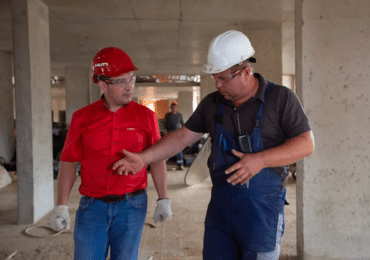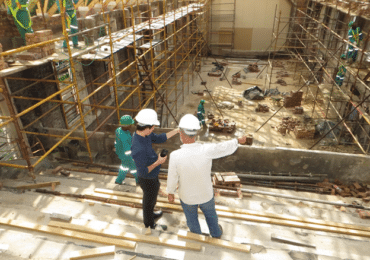Construction sites can be attractive targets for intruders, posing significant risks to the safety of workers, as well as potential financial losses due to theft or vandalism. Implementing effective security measures is crucial to ensure the protection of your construction site. In this blog post, we will explore various strategies and best practices to secure a construction site from intruders.

Conduct a Site Assessment
Before implementing security measures, it is important to conduct a thorough assessment of the construction site. This assessment involves identifying vulnerable areas and access points, evaluating existing security measures, and determining specific security needs based on project requirements.
By understanding the site’s layout and potential weak spots, you can develop a targeted security plan that addresses specific risks and enhances overall protection.
Establish Clear Perimeter Boundaries
Establishing clear perimeter boundaries is an important aspect of securing a construction site. By using temporary fencing, you can achieve setting up clear boundaries that warn outsiders and possible intruders. Temporary fencing serves as a physical barrier, creating a clear boundary that defines the limits of the construction site. Here are some relevant points about making use of temporary fencing to establish clear perimeter boundaries:
- Assess the Space: Before installing temporary fencing, it’s crucial to assess the site and determine where the boundaries need to be established. This will ensure that the fencing is strategically placed to enclose the desired area.
- Establish Boundaries: Once the space has been assessed, the temporary fencing can be set up to clearly mark the perimeter of the construction site. This helps prevent unauthorized access and ensures that only authorized personnel enter the site.
- Channel Pedestrian and Vehicle Movement: Temporary fencing not only acts as a physical barrier but also helps in directing the movement of pedestrians and vehicles. By creating organized pathways and channels, temporary fencing can enhance safety and maintain a smooth flow of traffic within the construction site.
- Psychological Barriers: In addition to physical deterrence, temporary fencing also establishes psychological barriers. The presence of fencing sends a clear message that the construction site is private property and access is restricted. This can discourage intruders and unauthorized individuals from attempting to enter the site.
- Compliance with Regulations: Temporary fencing can help construction sites meet regulatory requirements, such as those set by OSHA (Occupational Safety and Health Administration). These regulations often mandate the use of fencing to establish a safe perimeter.
Making use of temporary fencing to establish clear perimeter boundaries is an effective way to enhance the security and safety of a construction site. It provides a visible and physical deterrent against unauthorized access, helps channel pedestrian and vehicle movement, and ensures compliance with regulations.
In addition to physical barriers, it is crucial to clearly mark restricted areas with signage. These signs should indicate that the site is private property and unauthorized entry is prohibited.
Implementing access control measures, such as gates with key cards or biometric access systems, further enhances the security of the construction site by limiting entry to authorized personnel only.
Implement Surveillance Systems
Surveillance systems play a vital role in monitoring and deterring intruders. Selecting suitable security cameras that provide high-quality video coverage is essential. Position the cameras strategically to cover critical areas such as entry points, storage areas, and equipment yards.
Consider integrating video analytics and remote monitoring capabilities into your surveillance system. Video analytics can detect suspicious activities, such as unauthorized movement or loitering, and trigger alerts for immediate action. Remote monitoring allows you to keep an eye on the site from anywhere, providing real-time visibility and enabling quick response to potential security threats.
Lighting and Alarm Systems
Proper lighting is crucial for deterring intruders during nighttime hours. Install adequate lighting throughout the construction site, paying special attention to dark corners, access points, and high-value areas. Well-lit areas are less attractive to intruders and increase the chances of detecting any unauthorized activity.
Implementing an alarm system adds an extra layer of security to your construction site. An alarm system can detect unauthorized entry and immediately notify responsible parties, including security personnel or local authorities. Consider integrating motion sensors and alarms to provide a more comprehensive and responsive security solution.
Secure Equipment and Materials
Equipment and materials left unattended on construction sites are prime targets for theft and vandalism. To secure these valuable assets, it is essential to establish proper protocols and measures:
- Lock up tools, equipment, and valuable materials when not in use. Use sturdy locks and secure storage containers to prevent easy access.
- Utilize secure storage cages or designated areas within the construction site to store high-value items. These areas should have additional physical security features like reinforced walls and alarm systems.
- Implement inventory tracking systems to monitor the movement of materials. Regularly reconcile inventory records to ensure nothing goes missing unnoticed.
Personnel Security Measures
The people working on your construction site also play a crucial role in ensuring its security. Implement the following personnel security measures:
- Conduct thorough background checks for on-site workers and contractors before allowing them access to the site.
- Issue identification badges or access cards to authorized personnel. This helps identify who is authorized to be on-site and quickly identify any unauthorized individuals.
- Train employees on security protocols and emergency procedures. This includes reporting suspicious activities, securing equipment, and responding to potential security threats.
Regular Security Inspections and Maintenance
Security measures are only effective if they are regularly inspected, maintained, and updated. Conduct routine inspections of all security systems, including surveillance cameras, alarm systems, fencing, and lighting. Address any identified vulnerabilities or malfunctions promptly to ensure continuous protection.
As the construction site evolves, so should your security protocols. Regularly reassess site conditions, identify any new risks, and update security measures accordingly. By remaining proactive, you can stay one step ahead of potential intruders.
Collaboration with Local Authorities
Establishing a good working relationship with local law enforcement can be invaluable in enhancing your construction site’s security. Reach out to the local police department or security agencies to introduce them to your project and seek their advice on security best practices. Report any suspicious activities promptly, providing accurate and detailed information to aid their investigation.

Securing a construction site from intruders is essential to protect workers, assets, and the overall progress of the project. By conducting a thorough site assessment, establishing clear perimeter boundaries, implementing surveillance systems, ensuring proper lighting and alarms, securing equipment and materials, implementing personnel security measures, conducting regular inspections, and collaborating with local authorities, you can significantly enhance the security of your construction site.
Remember, each construction site is unique, and security measures should be tailored to its specific needs and risks. By following these strategies and best practices, you can create a safe and secure environment that minimizes the risk of intrusions, theft, and vandalism.

